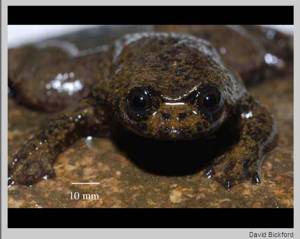One of the discoverers of the lungless frog on Borneo in Indonesia says in an Associated Press story that the Barbourula kalimantanensis looks “like a squished version of Jabba the Hutt.” So, Star Wars fans, you decide! Excerpt from the story:
“These are about the most ancient and bizarre frogs you can get on the planet,” (biologist David) Bickford said of the brown amphibian with bulging eyes and a tendency to flatten itself as it glides across the water.
“They are like a squished version of Jabba the Hutt,” he said, referring to the character from Star Wars. “They are flat and have eyes that float above the water. They have skin flaps coming off their arms and legs.”
A helpful explanation from the latest story I’ve come across:
While many frogs breathe partially through their skin, the Barbourula kalimantanensis is the first to have entirely evolved away from having lungs … This runs counter to one of the key events in evolution, when animals developed primitive lungs and moved from water to land.
“Here is a frog that has reversed that trend, it has totally turned against the conventional wisdom, if you will, of millions of years of evolution,” said Bickford, a biologist at the National University of Singapore.
The frog appears to have shed its lungs over millions of years to adapt to its home in the fast-flowing cold water rivers in the island’s rainforests, Bickford said.
Cold water contains more oxygen, making it possible to breathe through skin, he added.


You must be logged in to post a comment.